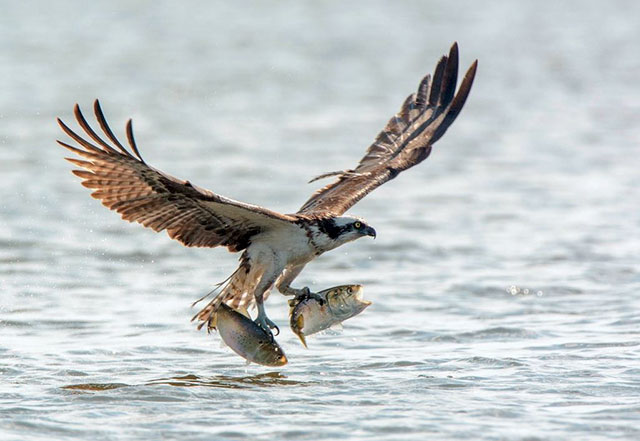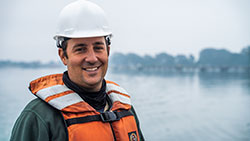
In a landmark collaboration between scientists and the fishing industry, commercial catch limits on Atlantic menhaden, a staple forage fish, will now depend on ecosystem models developed by Buchheister and his collaborators. The decision is a significant step towards an “ecosystem-based” approach to fisheries management that is more holistic and sustainable.
In a project funded by the nonprofit Lenfest Ocean Program, Buchheister and collaborator David Chagaris (University of Florida) developed two ecosystem models to inform management in the commercial menhaden fishing industry. Historically, catch limits depended solely on menhaden abundance and mortality rate, independent of the broader marine ecosystem. This single-species approach can oversimplify things and lead to negative impacts on predators and other species, Buchheister explains.
“Some of the big fish, like striped bass, tuna, and bluefish, who eat menhaden aren’t doing so well,” explains Buchheister. With his model, fisheries managers will now account for important predator species in the ecosystem, a paradigm shift in fisheries management.
Small and oily, Atlantic menhaden are not consumed by humans but are the largest catch, by volume, on the Atlantic coast. The abundant forage fish, which can form schools up to two miles wide, are commonly used in fish oil supplements, livestock feed, and dog food. Menhaden are also a critical food source for whales and birds.
To understand the impact of menhaden on the Atlantic ecosystem, Buchheister and Chagaris built two models of different complexities, accounting for 17 and 61 species groups. The models use a variety of data points to make predictions about how the ecosystem would change under different levels of menhaden fishing. The simpler 17-species model was used to develop a new target fishing rate for menhaden that accounts for predator needs, known as an ecological reference point (ERP). A practical metric for ecosystem outputs, the Atlantic States Marine Fisheries Commission (ASMFC) formally adopted this new ERP last August.

“By establishing this ERP for menhaden, we are explicitly accounting for the needs of ecologically and economically important species up the food chain,” says Buchhesiter. “In concept it’s simple, but in practice it’s difficult.”
The ASMFC’s use of ERPs and recognition of menhaden as a keystone species is big news. Now fisheries managers have a framework to track interactions across species, Buchheister explains. Also, they will be better prepared to address the tradeoffs that the fishing industry, conservationists, and other stakeholders care about going forward.
The ERP adoption comes at a critical time. With scientists forecasting warmer ocean temperatures, models like Buchheister’s could be used to make informed decisions about sustainable catch limits across an ecosystem.
HSU graduate student Max Grezlik is currently finalizing his thesis research on the topic by integrating climate projections into one of the ecosystem models.
“We expect that phytoplankton will decline and this will transfer up the food chain,” says Buchheister. Menhaden are a key link between phytoplankton and everything else.
With menhaden a prime candidate to test ecosystem approaches to fisheries management, Buchheister hopes that models like his will be used in other regions and international ocean conservation.
Note: This story was originally published on March 11, 2021.